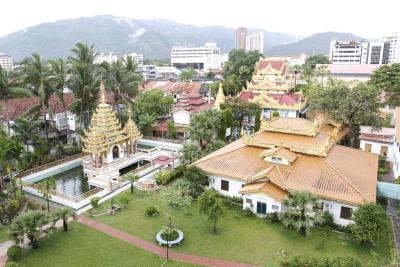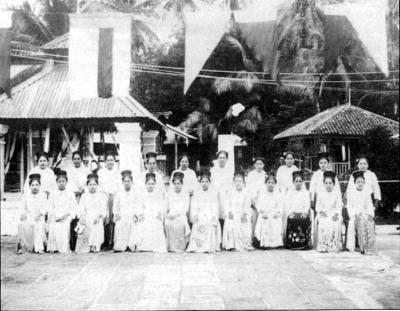 Long-standing: The Dhammikarama Burmese Buddhist Temple was founded in 1803, making it a prized historical site.
Long-standing: The Dhammikarama Burmese Buddhist Temple was founded in 1803, making it a prized historical site. AT 3.7km, Burmah Road is one of the longest roads in Penang, and surely one of the best-known routes on the island.
It begins at the junction of Penang Road and runs north-easterly towards the coastal road, until the junctions of Gottlieb Road, Bagan Jermal Road and Mount Erskine Road.
It is also one of the earliest roads, cutting through plantations and Burmese villages which surrounded the Pulau Tikus area in the old days.
One of the landmarks along Burmah Road is the 210-year-old Dhammikarama Burmese Buddhist Temple, which is the first of its kind in Malaysia.
The iconic temple, which is actually in Burmah Lane, a sideroad, provides historical evidence of the Burmese enclave in Penang.
Interestingly enough, another famous temple in the same area, but of Thai origin, is the Reclining Buddha Temple (Wat Chayamang-kalaram) famed for its 33m-long reclining Buddha statue.
 Early faces: The “Cheroot ladies” in 1930s. A large number of Malaysian Burmese are descendants of the ‘’Cheroot ladies’’ — the 300 Burmese female workers who were brought to Malaya in the 1890s to work in the cigar factories of Burmese Chinese Sin Yew Kyong.
Early faces: The “Cheroot ladies” in 1930s. A large number of Malaysian Burmese are descendants of the ‘’Cheroot ladies’’ — the 300 Burmese female workers who were brought to Malaya in the 1890s to work in the cigar factories of Burmese Chinese Sin Yew Kyong. Another iconic building, which is relevant to me, is the Wesley Methodist Church — the oldest Methodist Church in Malaysia, situated right at the junction of Burmah Road and Larut Road.
The Burmese presence, under the British, is still evident in Penang. Besides Burmah Road, there is Rangoon Road, which is off Burmah Road.
Burmah Road was spelt with an “h” instead of simply Burma Road because of the somewhat unusual British spelling of the early days.
Rangoon is simply the old name of Yangon, the former capital of Myanmar. Although the capital has been shifted to Naypyidaw, Yangon continues to be regarded as a main city. Naypyidaw remains much an administrative town, just like Putrajaya.
Mandalay Road, of course, is named after the second largest city and the last royal capital of Burma.
It is also known as the economic hub of Upper Myanmar and considered the cultural centre.
It is regarded as one of the best tourist spots, particularly those looking for gemstones.
Irrawaddi Road is named after the Irrawaddy River and the Irrawady Delta, where Myanmar’s rice-growing delta is located.
Then there is Tavoy Road — which is actually a reference to the Dawei, an ethnic group found in the Taninthary Region, about 600km away from Yangon.
Tavoy Road is a minor road off Burmah Road and it connects to Irrawaddi Road.
Situated right at the junction of Tavoy Road is the Seventh Day Adventist Church.
Facing the junction is the Penang Union Primary School, where the famed Penang banana pancake or apom is sold.
There are two push-carts sellers operating here — Ah Chooi and Ah Guan — and they are located about 20m away from each other.
They are actually siblings but the irony is that they do not talk to each other, at least not in public.
Ah Guan seems the more popular of the two, probably because of his public relations skills although many Penangites say their apom taste about the same.
He used to sell pisang goreng (banana fritters) in Jalan Air Itam Road, near the Jalan Kampung Melayu-Boundary Road junction, until his doctor told him that he should stop his trade if he wished to live longer.
Salween Road, meanwhile, is named after the mighty Salween River that flows through China, Myanmar and Thailand. It is one of the longest free-flowing rivers in the world.
Salween Road is home to a leafy residential area with many double-storey houses built in the 20th century and the road connects Irrawaddi Road and Arratoon Road.
Moulmein Road is named after Mawlamyine or Moulmein, the third largest city of Myanmar.
There is also Moulmein Close or Lengkok Moulmein, located opposite the Pulau Tikus police station.
The Swee Kong coffeeshop located at the road junction, serves decent Penang hawker fare.
Today, the Myanmar people are part of our foreign workforce and there are also those who are here as sojourners pending their attainment of refugee status to move on to recipient countries.
But not many are seen around the Burmah Road area, unlike in the early days when they were a common sight at the Weld Quay area, landing with goods at the shore, near the jetties.
They were easily distinguished from the other seamen because of the sarongs they wore and the language they speak.
Waiting for the bus at Weld Quay to take me home, we would often rush to the jetty just to catch a glimpse of these boats from Myanmar.
One of the best parts of growing up in Penang was the cosmopolitan nature of the state as a port. We were exposed to foreign culture and foreigners at a very early age.
From the American marines who stopped by George Town for their rest and recreation during the Vietnam War in the 1960s to the flower children or hippies who set up communes in Batu Feringghi, to the huge ships from India and the boats from Myanmar, it made growing up so much more exciting and interesting.
If The Lady, Aung San Suu Kyi, makes a trip to Malaysia, our diplomats should ensure that this enclave is part of her tour. She will surely feel very much at home.





